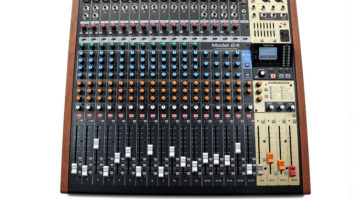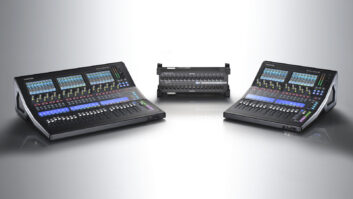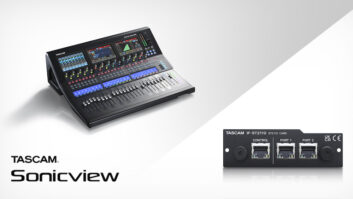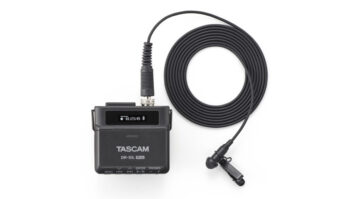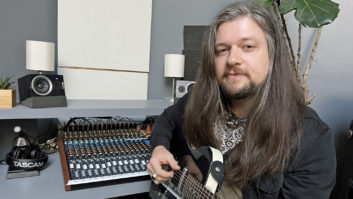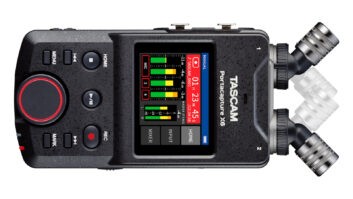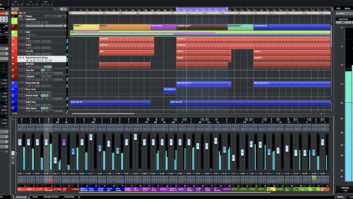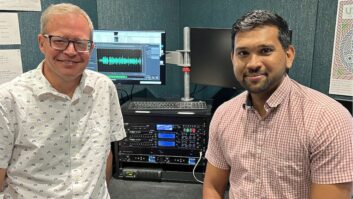Tascam’s DM-24 digital mixing console represents a large step toward providing home and project studio owners with pro capabilities in an affordable ($2,995 list) package. Sporting 24-bit/96kHz AD/DA converters, 32-bit floating-point processing, 100mm touch-sensitive motorized faders, internal automation, dynamics processing, extensive routing capabilities and the ability to cascade two consoles, the DM-24 provides numerous compelling reasons for digital studio owners to consider it as command central.
The DM-24 is optimized for use with Tascam’s family of DTRS machines, yet it’s flexible enough to work in several digital audio environments. I tracked and mixed with the DM-24 using ADAT XT-20s and Logic Audio Platinum 4.81 running on my Mac G4.
PHYSICAL LAYOUT
The DM-24 is a 32-channel/8-bus desk with six aux sends. While there are 17 actual faders (16 channel faders plus a stereo master), the DM-24 organizes channels into three layers of fader control, with backlit buttons to toggle between the layers. Each channel has common Mute, Select and Record Arm functions, plus an overload status LED that can double as an automation activity indicator. The top of the stereo master fader includes All Safe and Solo functions that are configurable in software. When the master Solo key is pressed, all channel mute keys become solo keys.
The DM-24 has 16 mic preamps and balanced line inputs on XLR and TRS jacks, and 16 insert jacks for outboard processors. The 48VDC phantom power is switched in groups of four channels. There’s no switch to select between mic and line inputs — users must be careful not to connect both inputs at the same time. Gain can be adjusted between 0 dB and 56 dB. The analog I/O section also includes balanced ¼-inch control room and unbalanced RCA studio monitor outputs, 2-track RCA inputs, XLR main stereo outs (with TRS insert jacks) and dual headphone outs. Four balanced ¼-inch sends and returns are software-assignable to act as inserts on any channel.
All ports for digital audio and control I/O are on the rear panel, including MIDI I/O/Thru ports, an RCA SMPTE/EBU timecode input, word sync I/O/Thru connectors, three TDIF connectors, ADAT optical I/O ports, a DTRS remote connector, RS-422, GPI, ¼-inch footswitch jack and two stereo digital I/O ports supporting AES/EBU and S/PDIF. Two expansion slots accept optional cards for cascade or additional AES/EBU, ADAT optical, TDIF or analog I/Os. The mixer uses passive heat-sink cooling, so there’s no fan noise — this is a very quiet mixer.
The DM-24 control surface includes sections to control the 4-band parametric EQ, channel assignments, library access (for recalling and storing dynamics/effects/EQ presets and mixer snapshots), transport and automation, and monitoring. Checking status and configuring each section are handled in its corresponding control screen.
INTO THE CONTROL SCREEN
Maneuvering the DM-24 is pretty straightforward. Rotary encoders (with ring LEDs), pods, soft keys, cursor buttons and a jog/data wheel navigate to and configure each channel’s settings using a decent-sized 320×240 LCD screen. The DM-24 has three main control screens: System Control (for overall settings), Global Control (adjusting groups of specific parameters) and Module screens (detailed control of each channel, which covers effects, dynamics, aux sends/returns, machine control, automation, surround, metering and monitoring, libraries, as well as analog and digital I/O assignments). Each screen can be accessed quickly via 12 buttons that double as a numeric keypad.
The hierarchy of pages is friendly, with only one sub-page associated with any given screen. And no matter where I was, one button jumped me back to the Module screen of the currently selected channel.
The Module screen contains the basic settings for each channel with soft-key menus to access the main setup, dynamics, EQ and aux send sub-pages for channels 1 through 32. (Bus and aux channels don’t use these menus.) The top of the Setup screen always has a graphic representation showing EQ settings, with a block diagram of your signal path directly below. The right-hand column shows stereo and dynamics metering, compressor, gate and phase-control switches, EQ/bus status, compressor insert-point indicators, as well as a grouping indicator for fader and mute groups. Along the bottom are the selected channel’s trim and pan controls. The central area of the screen is devoted to the following information.
SETUP
The Setup section resembles a channel patchbay, with switches for the channel source, the Aux 1-2 source, gates (channels 1 through 16 only), compressors and assignable inserts. Here, the compressor and assignable inserts can be placed pre- or post-fader, channel phase reverse is provided and channels 1 to 24 can be delayed up to 371.5 ms (@ 44.1 kHz).
AUX
The Aux Send page shows the levels, pre/post-fader selections and returns for all six auxes. Aux 1-2 also allows setting the source to mic/line or return. In the latter, Aux 1-2 can function as a tape return path, while channels 1 to 16 are used to send input channels direct-to-tape. While tracking, a recording snapshot in the library is available with these settings. During mixdown, Aux 1-2 can have the mic/line inputs routed to them instead. When routed to the stereo bus, the Aux 1-2 path essentially provides 16 extra channels at mixdown with pan and level control. The auxes default to fader control, but can be adjusted via the PODs below the LCD screen or using rotary encoders. Additionally, three global screens display all of the aux sends to configure their settings at once.
DYNAMICS
The Dynamics page provides a compressor for all 32 channels and a gate/expander on the first 16 channels. The controls are straightforward, and a library of presets for common applications is available. These are good, not great, dynamics processors that are quite clean, easy to control and — dare I say — almost warm. Special mention: The Hysteresis feature is excellent to tailor the gate’s response.
PARAMETRIC EQ
Hands down, one of the best aspects of the DM-24 is its 4-band parametric EQ (see Fig. 1). Settings can be adjusted via the four PODs below the screen. Alternatively, four rotary encoders can function as independent EQ controls for gain, frequency and Q. (In the latter case, HF, high-mid, low-mid and LF frequency bands can be selected via backlit equalizer buttons. This flexibility lets you adjust EQ for a given module, while tweaking aux sends or dynamics settings with POD controls.)
The HF and LF bands offer peak, shelf or lowpass operation; the two mid bands can act as notch or peak filters. Gain is ±18 dB, and the 24 Q settings range from 8.65 to 0.27. As with the dynamics processors, user- and factory-EQ presets are stored/recalled in the DM-24 library. With a limited 31 to 19k Hz frequency range, detailed applications may require dedicated outboard EQs, but the smooth, musical quality of the EQ and amount of control afforded are outstanding.
THE INS AND OUTS
The DM-24’s digital I/O functions like a digital patchbay, routing inputs and “returns” via virtual patch cables (see Fig. 2). Inputs include all mic/line inputs, digital inputs 1 and 2, internal effects returns and assignable returns. These inputs can be routed to any of 32 channels, so mic/line number 12 can be assigned to channel 4, effect return 2 can be assigned to channel 5, etc. The use of “return,” as in tape return, is a tricky bit of nomenclature. The DM-24 treats all TDIF, ADAT and option card-slot inputs as returns; these can only be assigned to channels 1 to 24. Channels 25 through 32 are input-only, so you can’t route any TDIF or ADAT channels to them. However, these channels can be used as effects returns, and the DM-24’s library section includes this routing within its many mixdown snapshots. [Note: The upcoming Version 2.0 software is said to allow channels 25 through 32 to access the return signals. Under V. 2.0, channels 1 to 16 can be used for input signals, while 17 to 32 can be used as tape returns. This negates the need for using Aux 1-2 as tape returns.]
While there is a limit of three return interfaces that can be used for tape returns, all outputs (TDIF, ADAT, AES/EBU, S/PDIF and option cards) are always active, which frees you up to assign and bus 8-channel mixes to different formats, like to ADAT or DTRS multitracks.
MONITORING
The console has an excellent monitoring setup. The Control Room section has selector buttons to monitor the hard-wired stereo outputs and three soft outputs that default to Aux 1-2, Digital In and 2TR In. Different sources can be selected via the Monitor screen. Also provided is a headphone-level control, talkback mic, main control room outs, mono switching, solo monitoring and two “smart” keys. The latter re-route the main control room out to the studio feeds or slated to the eight mix buses, the six aux buses and the stereo bus.
HIGH-SPEED/HIGH-RES
Switching the DM-24 to 88.2/96kHz operation increases fidelity for high-resolution work but reduces features. Rebooting the console set for this mode yields 16 tracks with four aux sends, one effect and one digital out. Basically, you lose half of the desk’s power, although all eight buses are available for surround mixing. Also note that the ADAT card doesn’t support 88.2 or 96kHz Lightpipe, but Tascam is working with third-party developers to address this issue.
IN SURROUND
In surround applications, DM-24 uses six of its eight buses to send the 5.1 mix. Output can be sent via TDIF, Lightpipe or the option card. Surround modes can also be configured as 2+2 and 3.1. Two side-by-side XY matrices in the Surround screen show two channels at a time, and the PODs manipulate the image.
A Global Boom screen allows users to uniformly edit the bass level for groups of channels. Like other project studio-priced mixers, the DM-24 lacks the ability to monitor surround mixes. Tascam is aware of this in its design and offers its stand-alone DS-M7.1 ($1,895) as a solution. It also lacks support for a joystick controller, and this won’t change. However, software V. 2.0 of the DM-24 will include various refinements for surround operations that add innovative surround panning via the data wheel.
INTERNAL EFFECTS
In addition to its dynamics algorithms, the DM-24 includes internal effects that can be patched as loop/inserts or in series (Effect1-Effect2). These include Tascam-designed algorithms for delay, distortion, chorus, flanging, phasing, de-essing and pitch shifting. Stored in 127 locations in the Effects section of the library, these can be customized and stored as user presets.
I found these effects fairly basic and decent — most users may prefer routing to dedicated external effects. Perhaps anticipating that users would need an extra enticement, Tascam struck a deal with TC Works to include reverb algorithms. Anyone who is familiar with TC Works’ MegaVerb will also be familiar with the sound. They’re serviceable but not on par with a good outboard TC or Lexicon box. Achieving proper imaging can be a challenge, so it’s best used for subtle jobs within the mix.
Tascam does include some cool mic and speaker-modeling emulation technology from Antares. The former applies characteristics of various high-end mics to your own microphone. This won’t turn a C3000 into a U87, but it may improve the sound. More importantly, I achieved sounds that I couldn’t possibly arrive at via EQ and compression alone. A poorly miked recording won’t be saved, but it may offer a wonderful weirdness that cuts through the mix. It’s highly recommended to users who are open to random discoveries and who like to experiment with textures. Antares’ speaker modeling simply lets you change your nice monitors into the boombox or computer speaker variety. Inserting this into the main stereo outs provides a reasonable idea of how your mixes will sound on tiny speakers.
MIDI AND MACHINE CONTROL
The DM-24’s MIDI implementation serves to send/receive controller data and program changes, sends MMC and locks to incoming MTC, backs up automation and library data, as well as updates the system software. You can program MIDI channel and controller numbers for the fader, mute keys and pan knobs for channels 1 through 32, allowing the DM-24 to control other devices, or vice versa. Another MIDI layer offers DAW control over faders, mutes and pans, acting as a control surface for programs such as Emagic’s Logic Audio or Steinberg’s Cubase.
The DM-24 can also control many devices via the R-422 port, MMC or the DTRS remote jack. The DM-24 can scan and detect connected devices, as well as map the transport of those devices. ADAT owners note: The DM-24’s software has not yet implemented the sync port on the optional ADAT I/O card. For now, you’ll need a BRC, MOTU MTP-AV or JLCooper dataSync2 and use MMC in lieu of ADAT sync. Each of these devices converts ABS timecode to MTC or SMPTE that the DM-24 can read. All timecode/sync settings are found in an Option screen for selecting SMPTE or MTC as the sync source. Common timecode frame rates of 24, 25, 29.97ND, 29.97D, 30D and 30ND are supported.
AUTOMATION
If flexible signal routing and great EQ make this board a good value, then the automation makes it a great one. The DM-24 lets you automate fader levels, mutes, EQ setting, aux send level, bus master levels, dynamics settings and library recall, as well as surround panning.
The DM-24 designers have reduced the number of steps required to begin automating a mix. Once a mix is set up and sync settings are established, automation is armed within the Automation menu. I started playing my MDM/DAW tracks, and as soon as the mixer read timecode, I pressed the Write button in the console’s Automation section and began mixing.
While automating my mixes, the faders were very responsive, easily punching in and out of automation and providing just the right amount of resistance when moved. The rotary encoder and POD moves can also be automated, but the knobs are not touch-sensitive. However, the software lets me adjust the punch-out time following a knob’s release, so I could customize their response. The DM-24 includes common Safe, Trim, Write to End, Rehearse and Undo features. And a useful Multi-Pass mode lets you continue writing automation once timecode has stopped.
Eight memory banks each store up to 8,000 events, and you are limited to 32,000 events per mix. Complex mixes will quickly swallow up memory, but I always had enough headroom to complete a mix. You don’t need a computer to run the automation, but you’ll probably use one to back up your automation data and library files. I’d prefer an onboard drive for backups, but Tascam wanted to keep the DM-24 costs down and figured most owners would have access to MIDI devices.
SOUNDING OFF
Monitoring in a quiet room on a pair of HD-1s with excellent cable, the DM-24 provided a very clean and transparent sound without any noticeable artifacts. The converters on this board are simply outstanding. This was particularly useful to evaluate the 16 mic pre’s, which are very good — much better than Mackie analog 8-bus in the same price range. However, the uneven gain distribution of the trim pots could be annoying to some engineers who discover the dramatic gain boost around 3 to 4 o’clock. For $200, Tascam offers an upgrade to improved taper trims.
While the manuals for the DM-24 are okay, they don’t ease the console’s learning curve. Thankfully, Tascam’s online DM-24 forum is one of the best I’ve seen, with respectful and responsive participants, saving hours of grief for anyone who is dedicated to learning this desk. Tascam representatives actively moderate and contribute to discussions, accepting suggestions from its user base and integrating them directly into software revisions. Speaking of software, DM-24 Version 2.0 was being released as we went to press. Some key features include an internal MIDI timecode generator, effects returns routing to stereo bus, pre-aux muting, new MIDI fader layers, direct surround panning, HUI emulation (Pro Tools, Digital Performer and Nuendo DAW control) and more.
Overall, the DM-24 offers an incredible value. Its excellent converters, flexible routing, good dynamics/EQ and automation more than compensate for any concerns regarding the onboard effects or the strange linear-trim pots. If you’re in the market for a powerful digital mixer at a rock-bottom price, then check this one out.
Tascam America, 7733 Telegraph Rd., Montebello, CA 90640; 323/726-0303; www.tascam.com.
Alex Artaud is a musician and engineer residing in Oakland, Calif.
